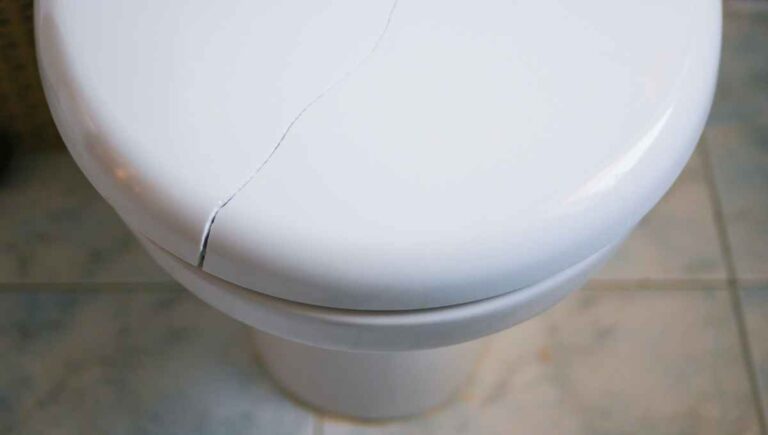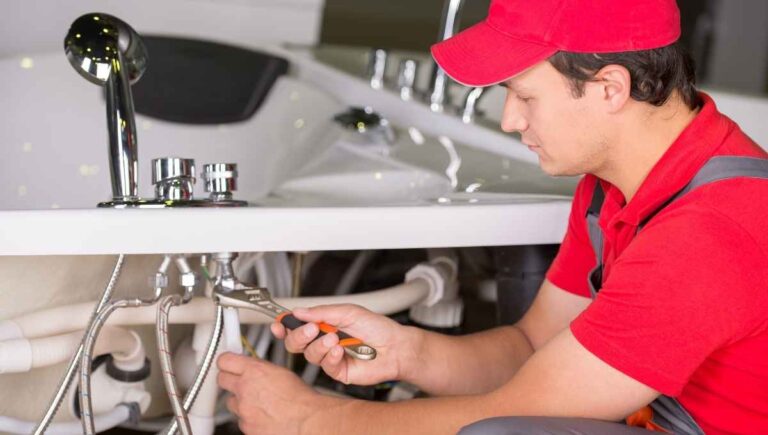Can a Shower Caddy Be Too Heavy? (4 Things to Avoid Doing)

Shower caddies are a convenient way to store and organize your bathroom essentials, but with all the items you need to put in them, it’s easy to end up with a caddy that’s too heavy.
If overloaded, a shower caddy can be too heavy. If the caddy is too heavy, it can cause damage to your shower or tub and make it difficult to maneuver. It can also be a safety hazard, especially if you’re hanging the caddy from a showerhead or other fixture.
The good news is we’re ready to tell you all about how much weight your shower caddies should be able to hold. Plus, we’ll discuss the different types of shower caddies and determine which is best. Check it out below!
This post contains affiliate links. This means Household Blogger may earn a commission should you make a purchase using any of our links. Please refer to our full affiliate disclosure policy for full details.
Here’s a Quick Pro Tip!
Having a shower caddy doesn’t have to be stressful. While most people don’t want to go drilling into their bathroom walls in order to keep their caddy attached to the wall, it can be an option.
However, before you go grab your drill, consider using one of these other shower caddy options instead:
1. Tension Shower Caddy – Who knew tension rods were so useful and space-saving?
2. Stainless Steel Shoulder Arm Caddy – Just be cautious not to overload!
3. L-Shaped Shower Caddy – Now corners don’t have to be dead space!
Weight Issues
If you’ve got a small bathroom, a shower caddy is a great way to use the little bit of extra space you may have in your shower area. Unfortunately, when your shower caddy doesn’t stay in place, it makes it difficult. So let’s get started by talking about how much weight a basic caddy can handle.
How Much Weight Can a Shower Caddy Hold?
The standard suction cup shower caddy can hold between 3 and 15 pounds, depending on size. This means most shower caddies can safely hold shampoo, conditioner, and your body wash of choice, but not much else.
While suction cup shower caddies are incredibly convenient for those of us with minimal shower space, they are limited in how much they can hold. Use caution if overcrowding your caddy, as it may disengage from the wall.
How Much Weight Can a Shower Arm Hold?
A shower arm (aka the thing that holds your shower head to the wall) can hold up to five pounds. However, adding excess weight can cause your shower head to sag and, in extreme cases, may cause the shower head to pop off the arm.
Shower caddies that go over the shower head should never have more than five pounds of shower accessories on them. Adding extra weight can seriously risk damaging your shower head, a problem no one wants.
How Do You Stop Your Shower Caddy From Falling?
You should secure your suction cup caddy firmly to the wall to prevent it from falling. The best way to ensure your suction cup stays on is to ensure that the cup and the wall are clean and dry before attempting to apply the cup.
Here is a full breakdown of how to make sure your suction cup stays in place:
- Clean the wall and the suction cups with dish soap or an all-purpose cleaner.
- Dry both surfaces carefully and completely.
- Apply rubbing alcohol to the cup and to your wall, and allow it to dry completely.
- Apply a small amount of petroleum jelly to the wall where you intend to place the suction cup.
- Press the suction cup firmly onto the wall, and hold it in place for at least 30 seconds.
- Allow the suction cup to set for at least a day before adding any weight.
Why Is My Shower Caddy Falling All the Time?
There are two main reasons why a shower caddy keeps falling. The first is that the suction cups aren’t sticking properly. Fix this by cleaning the area and the cup thoroughly and allowing it to dry before affixing the suction cup.
The second reason your caddy is falling is that you’re adding too much weight to it. If you overfill your caddy, gravity will take over, and the caddy will end up on the ground, regardless of how clean the wall is.
How Much Does a Shower Caddy Weigh?
The weight of a shower caddy depends on the materials it’s made from. For example, a plastic caddy may weigh as little as one pound, whereas stainless steel will weigh closer to five pounds.
When deciding what shower caddy will work best for your shower, it’s best to keep these weight differences in mind. For example, a small plastic caddy may only weigh one pound, but it can only safely hold about three.
A stainless steel caddy, on the other hand, weighs closer to five pounds but can safely hold up to 15 pounds as long as you apply it correctly.
How Do You Secure a Tension Shower Caddy?
To secure a tension shower caddy, first ensure you have the correct size for the height of your shower. Next, extend the tension rod to almost the room’s height, then place it. Finally, twist the rod until it is secure.
Using a tension shower caddy can be a great way to utilize the space in your shower. Additionally, tension shower caddies can hold more weight than their suction cup counterparts.
Shower Heads and Other Placement Options
There are plenty of options for shower caddies, but one of the most common is the type that goes over a shower head. Unfortunately, these can slip easily and cannot hold much weight. So now, we’ll discuss the best way to use these caddies and your other options.
Can a Shower Caddy Be Too Heavy for a Shower Head?
Hanging shower caddies, the kind that goes over a shower head and rests on the shower arm, can absolutely be too heavy for the shower head to support. When this happens, the caddy may slip off and fall to the ground.
Or worse yet, the shower head may become dislodged from the arm. If this happens, you may need to replace your shower head. However, you can mitigate this by keeping only light objects on your shower caddies, like loofas, razors, and small bottles.
How Much Weight Can a Showerhead Hold?
Your shower head can hold, at most, five extra pounds. That five pounds includes the shower caddy, meaning you shouldn’t keep large, heavy objects on your shower head caddy.
While you can help your shower caddy by placing suction cups on the wall to distribute the weight, minimizing how much weight you put on the shower head is still wise. Instead, consider using a tension caddy or even a suction cup caddy placed elsewhere in the shower.
Is It Safe to Hang a Shower Caddy on a Shower Head?
Hanging a shower caddy on your shower head isn’t inherently dangerous. However, you must be cautious about how much weight you place on your shower head. Excess weight may cause damage to the shower head.
Only place lightweight objects on a hanging shower head caddy. Save the heavy objects for the shelves of your shower. If you are short on space, you can also use a pocket shower curtain to save on space!
How Do You Secure a Shower Caddy to the Wall?
There are two ways to secure a shower caddy to the wall: permanent and non-permanent. Most shower caddies will come with screws to secure your caddy to the wall.
However, if you don’t prefer poking holes in your shower walls, you can always use suction cups or even command strips and hooks to hang your caddy. To use either, make sure the wall is clean and dry before placement. Additionally, allow your holder to set for at least 24 hours before adding any weight.
What Are the Best Shower Caddies?
The best shower caddies are the ones that save you space in your shower without compromising the walls or shower head integrity. For most, that means using a suction cup caddy.
Suction cup caddies are stuck to the wall, wherever you choose. They are easy to place and just as easy to remove, and they don’t damage your walls when taken off.
However, there are plenty of other options for your shower caddy:
How Do You Install a Shower Caddy Without a Shower Head?
Plenty of shower caddy options do not require hanging from the shower head. For example, tension rod caddies only require a tension rod placed in the corner of the shower. No showerhead needed!
To install a suction cup shower caddy:
- Clean the wall where you intend to place the caddy thoroughly and let it dry completely.
- Wipe the wall area and suction cups with rubbing alcohol and let them dry.
- Firmly place the suction cup in the desired location and hold for at least 30 seconds.
- Allow the suction cup to set for at least 24 hours before adding additional weight.
Caddy Rust Concerns
One of the biggest concerns for a shower caddy is what it’s made from. Plastic can be flimsy and can’t hold much weight, but won’t stainless steel rust quickly? So let’s look at the facts.
Do Aluminum Shower Caddies Rust?
Most aluminum shower caddies are rust-resistant and very rarely rust. You can also clean aluminum shower caddies easier than their plastic counterparts. To prolong its life even more, dry it once you’re finished in the shower.
Even without drying it after a shower, aluminum shower caddies are unlikely to rust. However, aluminum does corrode over time. Thankfully, this process takes years, and as long as you are not showering in salt water, it is unlikely to happen to your shower caddy.
Do Stainless Steel Shower Caddies Rust?
Just like their aluminum counterparts, stainless steel shower caddies are rust-resistant. Stainless steel is more likely to suffer from pitted corrosion, however. Save your caddy from this erosion by drying it after use.
If drying your shower caddy daily doesn’t feel like something you want to do, you can always give your stainless steel shower caddy a coat of rust prevention to help stop rust before it starts.
What Is the Best Rust-Free Shower Caddy?
Stainless steel or aluminum shower caddies are the best to keep rust-free. These metals are naturally rust-resistant, and unless exposed to harsh, sea-like conditions, they are unlikely to rust out in your shower.
Of course, you could use plastic shower caddies instead. While they will not rust, they may mold more easily, plus they aren’t typically as strong as their steel counterparts. This means they are more likely to be too heavy and fall.
How Do You Prevent Metal Caddies From Rusting in the Shower?
You can prevent an aluminum or stainless steel shower caddy from rusting in the shower by drying it after you’ve showered. Additionally, venting your bathroom helps remove the moisture in the air, helping to prevent rust from forming.
You can also use a rust-preventative treatment on your shower caddy and any other metal objects that will be living in your shower to help prevent rust from forming in the first place.
How Quickly Do Caddies Rust in the Shower?
As long as you take care of it, it should take years for a caddy to rust in the shower. However, if your caddy rusted quickly, it may have been made of a lower-quality metal or not treated with a rust-preventative.
Stainless steel should never rust, even exposed to the moisture of a shower. This is because stainless steel contains iron, along with a bit of nickel and chromium, which serves to protect the iron from rusting.
You might also enjoy our post on Do Shower Rods Stay With the House?
Related Questions
How Do You Keep Metal From Rusting in the Shower?
Make sure all the metal in your shower is made from stainless steel. Stainless steel is naturally immune to rusting due to its makeup. In addition, most metal shower caddies are brushed with rust preventative before being sold.
If you’re still worried that your metal objects may rust in your shower, ensure you always ventilate your bathroom properly. Removing the hot, moist air from an enclosed space quickly helps prevent rust.
Why Do Suction Cups Stop Working?
It is vital that you seal the suction cup correctly and perfectly. Otherwise, over time, the seal will slowly start to leak, allowing air inside until it eventually detaches and falls off of the wall.
You may want to try running your suction cup under hot water, then quickly drying it and replacing it on the wall. The heat of the water will soften the plastic and allow for better suction to the wall.
What Is the Best Portable Shower Caddy?
The best portable shower caddies allow room for all your bathroom accessories without being too bulky to carry around comfortably. Most college students prefer a plastic caddy that they can easily dry once they’ve showered.
Your shower caddy should be able to hold your shampoo, conditioner, razor, body wash, toothbrush, and toothpaste, along with any other skincare products you like to use. While this could get heavy, the right portable shower caddy should be able to handle it.
Final Thoughts
Keeping your shower caddy in place shouldn’t be too difficult. Just remember these four things. First, Don’t overload a caddy. Use more than one if necessary. Second, make sure the wall is clean. A dirty wall won’t allow the suction to hold properly.
Third, use the right kind of caddy. Stainless steel can hold the most weight and is rust-resistant. Fourth, finally, remember to air out your bathroom after a shower. Mold and rust can form on surfaces that hold water, which will eventually lessen your caddy’s structural integrity if you don’t.
We hope these shower tips and tricks help you decide which shower caddy is best for you. After all, even someone with a small shower deserves to have all the products they need for a nice, relaxing shower.












